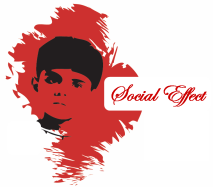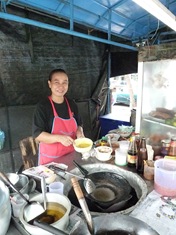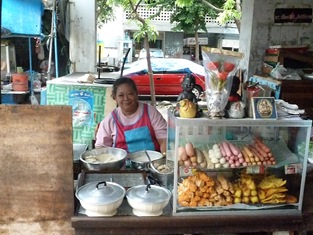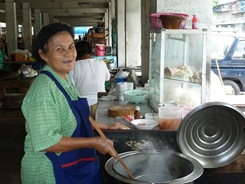The main reason for visiting Thailand, as ever, was to get beneath its tourist veneer and engage with its social and human challenges. Over the month I was there, I worked with projects involved in Medicare, Farming, Social Investment, Community Development, and randomly even Elephant Rescue.
Starting out in Bangkok at my friend Dev’s took me back to some of the work he had been involved with as part of YSEI (Youth Social Enterprise Initiative). Dev co-wrote a guide for young social entrepreneurs called Start-up and Change the World, which I thoroughly recommend reading.
Start-up and Change the World
Dev had been working with a Swiss Bank branching out into social investment, and it gave me a chance to explore the illusion that is ‘social’ investment with an insider. Sadly what I learnt did nothing to dispel my concerns around social investment, and the fact that Dev had quit out of disillusionment about sums it up.
Social Investing
Social Investment is the big hype of the moment. The apparent answer to all our scaling prayers. It is however only an option for social businesses, and not a viable funding strategy for general development work (see my Social Effect post on Financing Social Enterprises).
The investor is not looking first to fund programs that will transform lives and then generate returns, but to fund ones that first and foremost will provide the return on investment they or their clients need.
They are usually looking to fund new technologies, utilities, energy, products, enterprises and saleable services. The typical IRR is still 30% and for many investors this is just another opportunity to make money, gain competitive advantage in an increasingly socially aware market, and look good at the same time.
Aside from the few that are really trying to do something positive, I’ve already been pulled into extricating a series of social organisations from investors doing everything from under-the-radar land grabs, to fraud and brute exploitation in the sharing of profits. As a field it’s all still too new and exciting for much of the negative aspects to surface, but be sure that it will in the next few years.
Example: Rural Electricity from Rice Husks & Social Investment
Coincidentally, while in Bangkok I was asked to mediate between a ‘Social Investor’ and one of the farming non-profits I was working with. I’ll skip specifics in the name of professionalism. The investor was connected to one of their funders, and they felt that it might be beneficial all round if the relationship could be made to work. The two parties had been discussing things for about a year, but hadn’t come to any agreement.
The community organisation had been looking into small scale energy production from rice husks to ensure zero waste operation, and additional income to farmers. The investor however was interested in financing bigger 1-3megawatt size rural electricity infrastructures and the community organisation was being encouraged to sign up on the promise of exciting new financial opportunities.
The trouble is that no-one had asked the critical questions to understand the investor’s real motivation. After a little probing I realised they simply needed a local community partner entity to minimise their risks
- To smooth out getting all the planning, build and running permissions at a local level, which is otherwise a major risk in getting up and running.
- To ensure a steady and fixed price supply of rice husks for energy production. Previous experience had shown that farmers would agree on a price before start-up and then increase it once the infrastructure was up and running. These had major risk implications for profits and continued operation.
Further pushing revealed 3 major issues in the potential partnership
- The non-profit was not being made aware that they were essentially just required to minimise profit risk, rather than being seen as an equal partner in a human development endeavour.
- The investor had no actual intention of sharing any of their pro-formas or financial templates; so profits, costs and timelines were completely hidden from the non-profit.
- It also transpired that the investor wasn’t looking to commit to any set share of profits or co-ownership, but was only offering additional income for farmers through payment for rice husks, which might otherwise just go to waste. When pushed there was a lot of mention of potential ‘millions’ in the future, some of which might go to the community, but of course only after ‘breaking even’ in 7 or 10 years. It was all too cagey to be worth trusting.
The long and short of it was that the community organisation and its key resources would end up spending unknown hours of their time over months or years smoothing out administration and logistics and running of the plant, for the promise of an unknown, if any, financial return; while the investor stood to make huge amounts of money over a 5 to 20 year timeframe.
It was a no-brainer to advise the community entity against taking up the offer or wasting any more time on the matter.
Having gone through this process a few more times since then, when it comes to social investment, my usual advice is that if the organisation isn’t simply an alternative business, and doesn’t have legal, contractual and financial expertise equivalent to that of the investing entity, the power imbalance is too steep. However good it looks on the surface, the investor holds all the cards. Best avoid.
Microfinance and ‘Entrepreneurs’
While in Bangkok I was connected with a project called Step Ahead providing microfinance to women ‘entrepreneurs’. The CEO was out of town, so I didn’t really engage with them beyond the surface.
However it got me thinking. This concept of calling any recipient of micro-credit an entrepreneur is an interesting development in the social sector. ‘Entrepreneur’ is just a fancy word with implications beyond the reality. Street sellers are no longer just people trying to make a little money to get by as vendors or hawkers or stall owners, but are portrayed as vibrant exciting new Richard Bransons in the making.
It makes the financing entity look good, but the shame is that it obscures the human, the endeavour, and the struggle that continues regardless of the small amounts of over-priced credit being provided.
Below are some of the bright cheerful Thai women who have been taking out microfinance loans for years, but are still grinding it out. We should be able to do better for them.
Tackling Prostitution and The Importance of Listening
Through Step Ahead I met some American girls who were voluntarily working with male prostitutes in the city.
When looked at brutally, selling your body for sex is much the same as selling your body for any other kind of unpleasant physical labour. The key difference is the physical and mental risk to the individual, that makes it worth tackling and eradicating.
Physically the risk extends from STDs and the potential death sentence of AIDS, to extreme violence, all the way through to human trafficking and slavery. Mentally the risks lie in the social exclusion, damage to self-esteem confidence and hopefulness, and the emotional challenges that come with trauma, especially in the cases of forced prostitution.
Thai people are generally pretty tolerant of the sex industry and there aren’t the same stigmas attached to it as in the West. This extends even to male prostitution which is fairly common with the amount of sex tourism that goes on. In Thailand then, prostitution is often a choice, and on an individual level rather than consortia or agent controlled. This means that the individual does have the option to make a different choice, but financial circumstances counter the perceived personal risk.
The girls were aiming to start a non-profit providing alternative work options. In this case hospitality training (cleaning and making rooms or waitering in hotels), because they’d seen that the training was available and funders were offering money to pay for it. The trouble was they just couldn’t get buy in or take up from the men they were trying to help.
After some discussion it transpired that given a choice, all the men wanted to do was set up and run their own small street stalls, mostly as food vendors. Cleaning rooms or running after hotel clients was not their idea of an improvement.
This raises a really important point in the design of social programmes. The intervening agent often works from their own point of view, assumes they know what’s best, and doesn’t actually listen properly to the people they want to help.
The intent is pure but the approach is driven by what they can offer rather than what is requested. To create outcomes that last, social entrepreneurs must listen to and work within the motivations of the people they want to help. If they cannot provide what’s both wanted and needed, they’re unlikely to be successful with lasting transformation.
----------
While in Thailand I also worked with a series of other projects, from Medical Negligence to Rice Farming, Multi-lingual Learning and Elephant Rescue, but I’m going to have to save those for another post!









